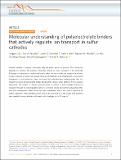Molecular understanding of polyelectrolyte binders that actively regulate ion transport in sulfur cathodes
Author(s)
Li, Longjun; Pascal, Tod A.; Connell, Justin G.; Meckler, Stephen M.; Ma, Lin; Prendergast, David; Helms, Brett A.; Fan, Frank Yongzhen; Chiang, Yet-Ming; ... Show more Show less
Downloads41467-017-02410-6.pdf (1.896Mb)
PUBLISHER_CC
Publisher with Creative Commons License
Creative Commons Attribution
Terms of use
Metadata
Show full item recordAbstract
Polymer binders in battery electrodes may be either active or passive. This distinction depends on whether the polymer influences charge or mass transport in the electrode. Although it is desirable to understand how to tailor the macromolecular design of a polymer to play a passive or active role, design rules are still lacking, as is a framework to assess the divergence in such behaviors. Here, we reveal the molecular-level underpinnings that distinguish an active polyelectrolyte binder designed for lithium-sulfur batteries from a passive alternative. The binder, a cationic polyelectrolyte, is shown to both facilitate lithium-ion transport through its reconfigurable network of mobile anions and restrict polysulfide diffusion from mesoporous carbon hosts by anion metathesis, which we show is selective for higher oligomers. These attributes allow cells to be operated for >100 cycles with excellent rate capability using cathodes with areal sulfur loadings up to 8.1 mg cm[superscript -2].
Date issued
2017-12Department
Massachusetts Institute of Technology. Department of Materials Science and EngineeringJournal
Nature Communications
Publisher
Springer Nature
Citation
Li, Longjun, et al. “Molecular Understanding of Polyelectrolyte Binders That Actively Regulate Ion Transport in Sulfur Cathodes.” Nature Communications, vol. 8, no. 1, Dec. 2017. © 2017 The Authors
Version: Final published version
ISSN
2041-1723